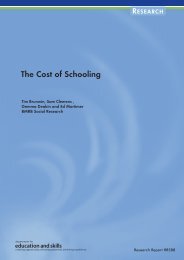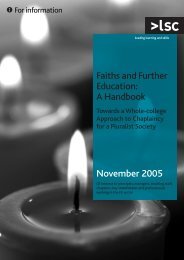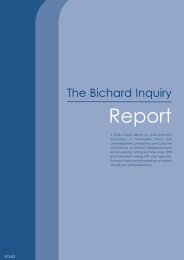Recognising and recording progress and achievement in non ...
Recognising and recording progress and achievement in non ...
Recognising and recording progress and achievement in non ...
You also want an ePaper? Increase the reach of your titles
YUMPU automatically turns print PDFs into web optimized ePapers that Google loves.
<strong>Recognis<strong>in</strong>g</strong> <strong>and</strong> Record<strong>in</strong>g Progress <strong>and</strong> Achievement <strong>in</strong> Non-accredited Learn<strong>in</strong>g<strong>Recognis<strong>in</strong>g</strong> <strong>and</strong>Record<strong>in</strong>g Progress<strong>and</strong> Achievement<strong>in</strong> Non-accreditedLearn<strong>in</strong>gIntroduction1 This document is for action. It sets out theapproach learn<strong>in</strong>g providers should take for identify<strong>in</strong>glearners’ success <strong>in</strong>, <strong>and</strong> quality-assur<strong>in</strong>g,<strong>non</strong>-accredited learn<strong>in</strong>g.2 <strong>Recognis<strong>in</strong>g</strong> <strong>and</strong> <strong>record<strong>in</strong>g</strong> <strong>progress</strong><strong>and</strong> <strong>achievement</strong> <strong>in</strong> <strong>non</strong>-accredited lean<strong>in</strong>g (RARPA)is an <strong>in</strong>itiative to raise the quality of <strong>non</strong>-accreditedteach<strong>in</strong>g <strong>and</strong> learn<strong>in</strong>g. The RARPA approach has twoaspects, the staged process, <strong>and</strong> the quality assurancearrangements necessary to form judgements aboutthe learn<strong>in</strong>g, for self-assessment purposes<strong>and</strong> quality improvement.3 RARPA has evolved from an action research baseof committed practitioners <strong>and</strong> researchers to becomea cornerstone of the New Measures work with<strong>in</strong>the Success for All agenda. The application of RARPApromotes good practice <strong>in</strong> teach<strong>in</strong>g <strong>and</strong> learn<strong>in</strong>g,puts learners at the centre of the learn<strong>in</strong>g process,encourages professional development <strong>and</strong> enableseffective quality assurance <strong>and</strong> quality improvementby learn<strong>in</strong>g providers.4 The “Evaluation report on the RARPA pilot projectsApril 2003 – March 2004” (LSDA <strong>and</strong> NIACE 2004)demonstrated that there are no ‘no-go areas’for RARPA. It is effective <strong>in</strong> all areas of learn<strong>in</strong>g,learn<strong>in</strong>g contexts, with all types <strong>and</strong> ages of learners<strong>and</strong> with learn<strong>in</strong>g activities of the shortest durationto long-term programmes.5 The LSC has asked all providers to committo RARPA <strong>in</strong> their three-year development plansas the approach <strong>and</strong> means for quality-assur<strong>in</strong>g their<strong>non</strong>-accredited learn<strong>in</strong>g activities. It expects all learn<strong>in</strong>g,accredited <strong>and</strong> <strong>non</strong>-accredited, to be <strong>in</strong>cluded<strong>in</strong> providers’ self-assessments. These arrangementswere met with unanimous agreement <strong>in</strong> the responsesto the RARPA Progress Paper (LSC 2004, LSC 2005).6 Learn<strong>in</strong>g that does not lead to externalaccreditation represents a small but significant partof the provision delivered across the learn<strong>in</strong>g <strong>and</strong> skillssector. Such learn<strong>in</strong>g is often highly valued by learners<strong>and</strong> may represent a significant step <strong>in</strong> their personaljourneys. These courses are typically part time <strong>and</strong> <strong>non</strong>vocational.They can also take place <strong>in</strong> work-basedlearn<strong>in</strong>g, for example, Entry to Employment (E2E)programmes (which currently have approximately30,000 learners participat<strong>in</strong>g) <strong>and</strong> <strong>in</strong> Centresof Vocational Excellence (CoVEs).7 Non-accredited learn<strong>in</strong>g is a vital part of lifelonglearn<strong>in</strong>g, <strong>in</strong>clud<strong>in</strong>g first steps learn<strong>in</strong>g, personal<strong>and</strong> community development learn<strong>in</strong>g, opportunitiesfor older learners <strong>and</strong> specialist provision for learnerswith learn<strong>in</strong>g difficulties <strong>and</strong>/or disabilities.These courses are crucial for encourag<strong>in</strong>g thosewho would not otherwise participate to get <strong>in</strong>volved,enjoy learn<strong>in</strong>g <strong>and</strong> <strong>progress</strong>.8 The term <strong>non</strong>-accredited learn<strong>in</strong>g is usedto describe formal <strong>and</strong> <strong>non</strong>-formal provision thatdoes not lead directly to any form of externalaccreditation, award or qualification. Non-accredited1
















